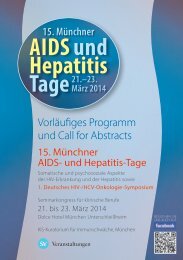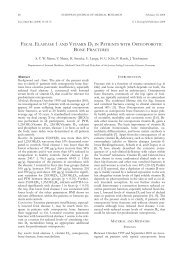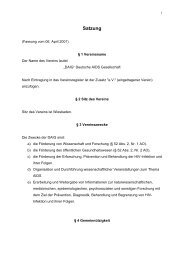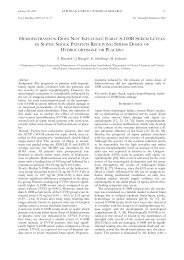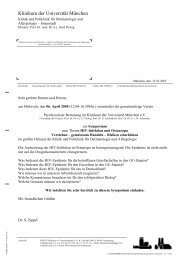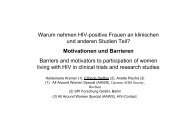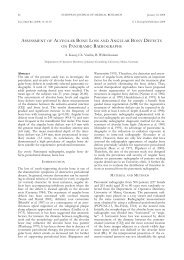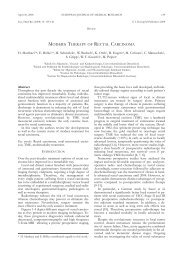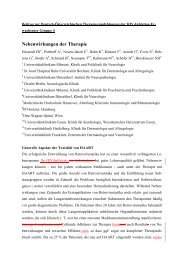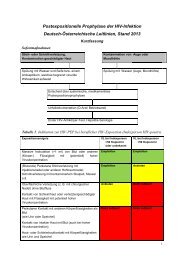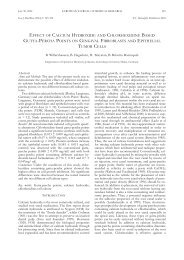European Journal of Medical Research - Deutsche AIDS ...
European Journal of Medical Research - Deutsche AIDS ...
European Journal of Medical Research - Deutsche AIDS ...
You also want an ePaper? Increase the reach of your titles
YUMPU automatically turns print PDFs into web optimized ePapers that Google loves.
92 EUROPEAN JOURNAL OF MEDICAL RESEARCH<br />
June 27, 2007<br />
Conclusions: Results support switching from a stable CBVcontaining<br />
HAART to a completely qd regimen <strong>of</strong> TVD plus<br />
third divergent partner given that virologic (< 50 c/mL) and<br />
immunologic control were maintained with the additional<br />
benefit <strong>of</strong> Hb increasing significantly.<br />
D.34 (Poster)<br />
Successful salvage therapy with Darunavir and<br />
TMC-125 in a patient with a four-class drug<br />
resistant Tipranavir-experienced HIV-1 strain<br />
Harrer E. 1 , Müller S.M. 1 , Korn K. 2 , Walter H. 2 ,<br />
Schmidt B. 2 , Harrer T. 1<br />
1 Universitätsklinikum Erlangen, Medizinische Klinik 3,<br />
Klinische Infektionsimmunologie, Erlangen, Germany,<br />
2 Universitätsklinikum Erlangen, Institut für Klinische und<br />
Molekulare Virologie, Erlangen, Germany<br />
Introduction: Multiresistant HIV-1-infected patients failing<br />
therapy with tipranavir and T20 have only limited treatment<br />
options. TMC-125 and darunavir are newly introduced antiretroviral<br />
drugs with potent activity against resistant HIV-1variants.<br />
Here, we report on the successful salvage therapy in<br />
a multiresistant patient using TMC-125 and darunavir.<br />
Methods: The then 34-year old patient was diagnosed with<br />
HIV-1-infection in 1993 when he presented with herpes zoster<br />
and a CD4 count <strong>of</strong> 120/�l. Since 5/1993 he was treated with<br />
all available antiretroviral drugs: AZT, AZT+DDC,<br />
AZT+DDI, then 3-5 drug combinations including D4T, 3TC,<br />
DDI, ABC, TDF, loviride, EFV, HU, RTV, SQV, NLV, IDV,<br />
APV, LPV, TPV, alpha-IFN, T20. Most newly started therapies<br />
could induce a transient rise <strong>of</strong> CD4-counts and a reduction<br />
<strong>of</strong> HIV-1 viremia, but viral load could never be suppressed<br />
below the limit <strong>of</strong> detection. In July 2006 he showed a<br />
high viral load on treatment with AZT, 3TC, TDF and<br />
tipranavir/r. Genotypic resistance analysis showed resistance<br />
to all drugs <strong>of</strong> the current and preceding antiretroviral regimens<br />
with following mutations: NRTI: M 41 L, E 44 A, D 67<br />
N, L 74 I, V 75 M, F 77 L, V 118 I, M 184 V, H 208 Y, L 210<br />
W, R 211 K, T 215 Y, K 219 N; NNRTI: K103N; PI: L 10 I, I<br />
13 V, K 20 R, L 33 F, M 36 I, I 54 V, L 63 P, A 71 V, V 82 T,<br />
I 84 V, L 90 M. gp41 was not analysed, but T20 resistance<br />
had been documented two years ago.<br />
Results: In August 2006, as his viral load increased to 170<br />
000 and his CD4-count fell to 45/�l, tipranavir/r was exchanged<br />
by a combination <strong>of</strong> darunavir/r and TMC-125.<br />
AZT,3TC and ten<strong>of</strong>ovir were continued and, in addition, T20<br />
was reinitiated, but was stopped after 4 days due to strong local<br />
injection site reactions. For the first time in the patient´s<br />
treatment history, this combination could decrease viral load<br />
below 50 copies/ml. 6 months after switching therapy his viral<br />
load is still suppressed and his CD4 count increased to<br />
226/�l.<br />
Conclusion: This case demonstrates that the combination <strong>of</strong><br />
darunavir/r and TMC-125 can exert a potent antiretroviral effect<br />
even on highly resistant HIV-1 variants. Due to different<br />
patterns <strong>of</strong> resistance mutations darunavir/r may retain activity<br />
against tipranavir resistant HIV-1 strains.<br />
D.35 (Poster)<br />
Behandlung von Patienten mit Darunavir im<br />
klinischen Alltag – Woche 12 Ergebnisse<br />
Therapieverlauf, Vorhersagbarkeit des<br />
Therapieansprechens mithilfe verschiedener<br />
Resistenzalgorhythmen<br />
Baumgarten A. 1 , Berg T. 2 , Dupke S. 1 , Carganico A. 1<br />
1 Gemeinschaftspraxis Dupke/Carganico/Baumgarten, HIV-<br />
Schwerpunktpraxis, Berlin, Germany, 2 Labor Berg, Berlin,<br />
Berlin, Germany<br />
Ziel: Behandlung von 19 Patienten mit einer chronischen<br />
HIV-Infektion im Rahmen einer antiviralen Therapie mit<br />
DRV im Rahmen von Studien in unserer HIV-Schwerpunktpraxis.<br />
Es handelte sich um intensiv vorbehandelte Patienten<br />
mit multiplen Resistenzen. Die Umstellung erfolgte aufgrund<br />
von virologischen Versagen der Vortherapien bei Multiresistenzen.<br />
Methoden: Die Umstellungen erfolgten resistenzgesteuert auf<br />
ein DRV-haltiges Regime mit begleitendem optimalen Backbone.<br />
Als OBR wurde bevorzugt TZV und TDF (58%) eingesetzt.<br />
32% der Patienten (n=6) erhielten zusätzlich ENV.<br />
Ergebnisse nach Woche 12: Eine VL-Reduktion von 1log<br />
Stufe gelang bei 95% der Pat. (n=18), eine Reduktion um 2log<br />
Stufen bei 84% (n=16). 58% der Pat. (n=11) hatten nach drei<br />
Monate eine Viruslast von



